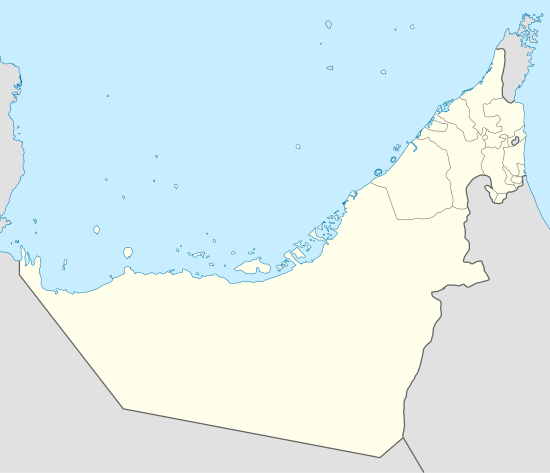Wadi Wurayah
| Wadi Wurayah National Park | |
|---|---|
 | |
| Location | Fujairah, United Arab Emirates |
| Nearest city | Masafi |
| Coordinates | 25°24′N 56°15′E / 25.400°N 56.250°E[1]Coordinates: 25°24′N 56°15′E / 25.400°N 56.250°E[2] |
| Area | 12,700 hectares (31,000 acres) |
| Established | 2009 |
| Official name | Wadi Wurayah National Park |
| Designated | 10 July 2010 |
| Reference no. | 1932[3] |
Wadi Wurayah is a 12,700 hectares (31,000 acres) area between the towns of Masafi, Khor Fakkan and Bidiyah in the United Arab Emirates. It has been designated as Ramsar Wetland of International Importance.[4]
Flora and fauna
Wadi Wurayah is home to more than 100 species of mammals, birds, reptiles and amphibians, as well as more than 300 species of plants. Famous for its scenic waterfall set amid the Hajar Mountains, Wadi Wurayah is recommended as a must-see in UAE for off-road and tourist guides. It has streams and pools dotted around the rocky outcrops. It is one of few remaining places in the world where the endangered Arabian tahr[5][6] still roams free. Conservationists believe it to be among the last places in the UAE where the Arabian leopard, which has not been seen in the UAE since 1995, still survives. A footprint of a leopard was found here.[7] The same is true for the caracal lynx, a small, shy predator, which like the leopard is persecuted by farmers who believe it targets chickens and goats. The wadi is also home to the Garra barreimiae, a type of freshwater fish that lives only in Al Hajar Mountains. Among the 208 species of plants is a species of wild orchid unique to the UAE, the Epipactis veratrifolia.[8] In 2018, an Indian crested porcupine was spotted here.[9][10]
Protected area
On 16 March 2009, the Wadi Wurayah became the first protected mountain area in the United Arab Emirates, after a three-year campaign by the Emirates Wildlife Society in Association with World Wide Fund for Nature, with the support of HSBC Bank Middle East Limited.[11] In addition to the conservation of the area's delicate ecosystem, EWS-WWF have also set up camera traps to photograph the more elusive wildlife, and arranged field trips for students to help raise awareness of the area.[12]
See also
References
- ↑ "The Annotated Ramsar List: United Arab Emirates". The Ramsar Convention on Wetlands. Retrieved December 14, 2012.
- ↑ "The Annotated Ramsar List: United Arab Emirates". The Ramsar Convention on Wetlands. Retrieved December 14, 2012.
- ↑ "Wadi Wurayah National Park". Ramsar Sites Information Service. Retrieved 25 April 2018.
- ↑ "The United Arab Emirates (UAE) designates Wadi Wurayah National Park as its second Wetland of International Importance". The Ramsar Convention on Wetlands. Retrieved December 14, 2012.
- ↑ "Newborn Arabian tahr discovered on Jebel Hafeet". The National. 2015-03-12. Retrieved 2018-03-30.
- ↑ "Arabian Tahr gets royal protection". WWF. 2009-04-28. Retrieved 2018-03-30.
- ↑ Edmonds, J.-A.; Budd, K. J.; Al Midfa, A. & Gross, C. (2006). "Status of the Arabian Leopard in United Arab Emirates" (PDF). Cat News (Special Issue 1): 33–39.
- ↑ Establishment of Wadi Wuraya Mountain Protect Area, Fujairah, WWF
- ↑ Haza, Ruba (2018-09-12). "Species of porcupine seen for first time in the Fujairah". The National. Retrieved 2018-09-13.
- ↑ De Leon, Janice Ponce (2018-09-13). "First confirmed sighting of Indian crested porcupine in UAE". Fujairah: Gulf News. Retrieved 2018-09-13.
- ↑ Wadi Wurayah becomes the UAE's first mountain protected area, Wildlife Extra
- ↑ Wadi Wurayah 2006 - ongoing, WWF